From working-class enclave to trendsetting hub, Mile End has transformed over the last century. While the neighbourhood's businesses have always shaped its character, it's the people who live and work here who make the area unique.
From working-class enclave to trendsetting hub, Mile End has transformed over the last century. While the neighbourhood's businesses have always shaped its character, it's the people who live and work here who make the area unique.
The structure at 5505 St-Laurent Blvd. was built in 1904, and was first occupied by clothing manufacturing giant John W. Peck & Company Ltd. As an incentive to set up shop in the neighbourhood, the company was offered a 20-year tax exemption from the municipality of St-Louis (the area that was annexed by city of Montreal in 1910 and eventually became known as Mile End). The tax break was given on the condition that Peck & Co. build a decent factory and hire locals — and the company did both.
The first decade of the century saw a construction boom, and the population of St-Louis more than tripled, reaching 37,000. By 1913, the Peck building had expanded toward St-Dominique St. to accommodate new employees.
Two years later, Peck & Co. was considered to be at the forefront of country’s clothing manufacturing industry. The growing business, obliged to source workers nearby, inevitably made a huge impact.
“It involved the whole neighbourhood,” explained Susan Bronson, Mile End historian and architect. “Suddenly, this whole area around St-Laurent Blvd., which hadn't been developed, started to get developed — it was major.”
- Susan Bronson, Mile End historian
Peck & Co. closed its doors in 1930, but the building continued to be occupied by a medley of smaller clothing manufacturers and subcontractors until the local industry petered out in the 1980s.
The 1910s, '20s and '30s saw a large Jewish influx to the area, many to fill jobs in the clothing industry. In the '40s much of this population moved westward in hopes of upgrading from the area that had become known as somewhat of a ghetto. When the Jewish community moved on, many retained ownership of their property — triplexes and duplexes — which would soon provide cheap vacancies for the neighbourhood's newcomers to rent.
The late '40s, '50s and '60s brought a wave of post-war immigrants from Europe to the area, mainly Portuguese, Greeks and Italians. Many found work in the manufacturing industry, while others started their own small businesses. Together, these new residents built themselves a village they grew to love — one they still reminisce about today.
Victoria Furfaro grew up in Mile End. In 1970, her Italian father, Rocco, opened his own coffee bar in town. Though he didn’t know it then, his friendly neighbourhood hub on St-Viateur and Waverly would one day become a beloved Mile End institution — he called the place Olimpico.
Now, more than four decades later, the café is filled with newspaper clippings, has become a frequent pit stop for celebrity guests, and its many regulars passionately swear by it.
“I remember, for my dad it was a place for gathering his friends,” Furfaro said, looking around from a table just behind the coffee bar at Olimpico, which she now runs alongside her sister. “This was never only a business to sell coffee, you’d come spend a couple of hours here.”
Furfaro speaks passionately about the neighbourhood where she was raised. She remembers that despite the vibrant and fresh multiculturalism of her childhood, language barriers were entirely absent. “You spoke Italian, Greek, Portuguese, and still, businesses survived,” Furfaro said, noting that her Italian father spoke neither French nor English when he came here.
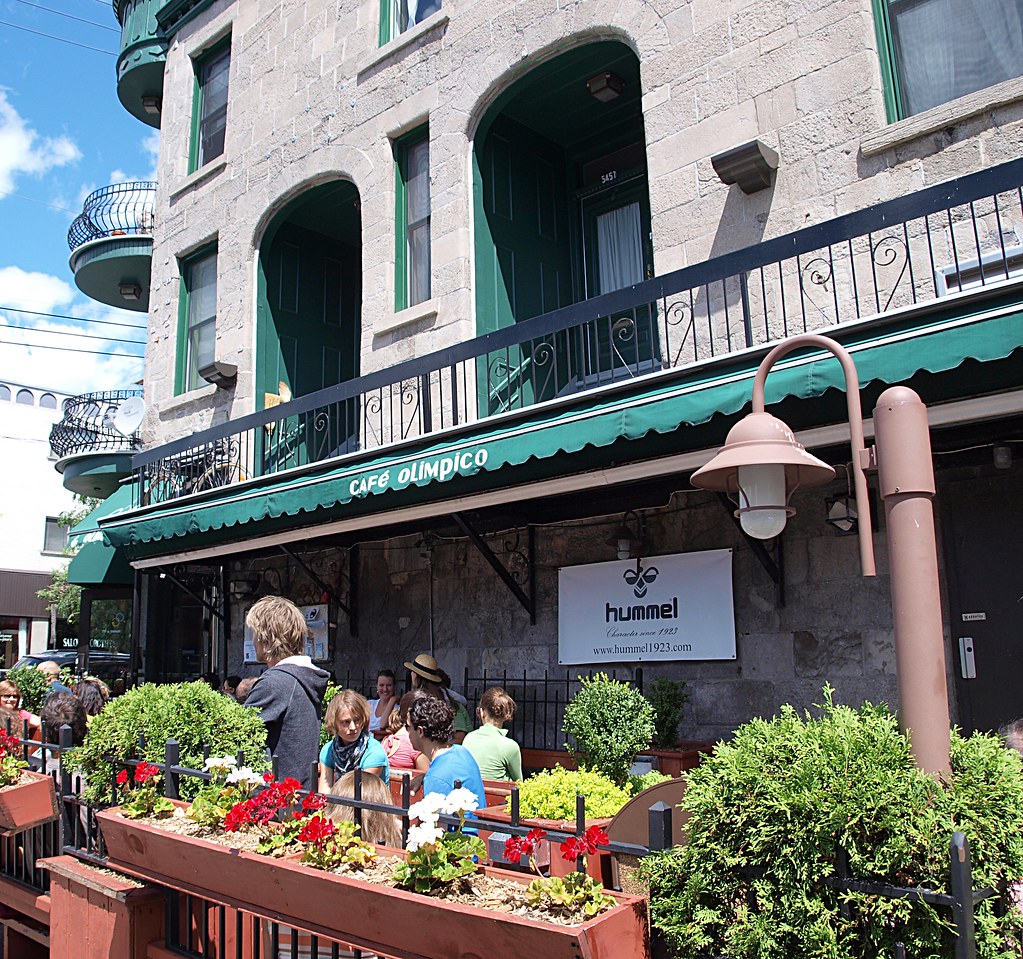 The Café Olimpico terrace is a favourite for Mile Enders come summer. Photo by Emmanuel Milou
The Café Olimpico terrace is a favourite for Mile Enders come summer. Photo by Emmanuel MilouToday, Furfaro says she does her best to maintain the business as a place to find a familiar face and a chat, and not just a coffee. “We have all walks of life that come in, you just have to be yourself,” she said. “And, the boys (who work the coffee bar) are great, they'll call you by your name — I don't know where else you have that bond in Montreal.”
Claudine Schirardin moved into Mile End in the early '70s. She used to work at Lambert-Closse school on the corner of St-Urbain and Bernard, where she ran its daycare for nearly three decades. Schirardin’s memories of the area are quite similar to Furfaro’s — a place where everybody knew their neighbours.
“I used to pass by the same place and I’d see an Italian woman sweeping the sidewalk,” Schirardin recalled. “I’d make a smile and she’d make a smile, maybe we’d never go further than that, but there was a connection. People like to have relations here.”
From those relations, a neighbourhood group was formed in 1982 called The Mile End Citizen’s Committee. Its mission was to act on and address residents' concerns. The group remains active today, and Schirardin is the committee’s longest sitting member, having been there since Day One.
After the clothing industry fizzled inside and around the Peck building, it left an array of vacancies — that meant the area was not only empty, but cheap.
As a result, the '80s brought the a new wave of people to town — artists.
“There were abandoned workshops, so it’s not original at all that the artists went there and found apartments with quite low rent,” said Laurent Simon, an associate professor of management at business school HEC Montréal.
The thriving artistic scene made Mile End hot, a place where people and businesses wanted to be. By the '90s, companies from the film and then later the IT industry also started moving in.
The neighbourhood's newfound appeal led to an increase in rents, and artists were soon struggling financially as a result of the allure they themselves had created. Many moved out of the Peck building and into the giant megastructures on de Gaspé, behind it.
In the early 1990s, a digital imaging company named Discreet Logic moved into the Peck building, they left in 1997.
Peck’s next tenant was a video-game company from France with a staff of 50 that quietly moved into the fifth floor. Ubisoft Entertainment was enticed to open an office at this location — similarly to Peck & Co. — by a promise of government aid and tax credits. And just like when the clothing manufacturing company moved in, things in Mile End were now about to really change, again.
It’s noon on the corner of St-Laurent Blvd. and St-Viateur St., and the floodgates have opened.
The outpouring from the Peck building is similar to when the final school bell of the year sounds. But really, this is just a standard weekday lunch hour.
Area workers who aren’t employed by Ubisoft have learned to take lunch a little earlier or a little later to dodge the rush. Otherwise, they venture out knowing that Boulangerie Clarke will be slammed, and not to even bother trying to hit up Soy on St-Laurent if it’s a Monday and some of the regular favourite lunch spots are closed.
Gone are they days when Ubisoft quietly existed on the fifth floor of 5505, unbeknownst to everyone around it. Today, the company staffs nearly 2,500, packs the entire Peck building and has begun seeping into several floors of the buildings behind it.
The 2000s brought a slew of new dining options to St-Viateur in part to accommodate Ubisoft’s daily surge of hungry people. Many area merchants now offer “Ubisoft” discounts, and some loosely gage the average midday spending by Ubisoft workers at between $35,000 and $40,000 each week.
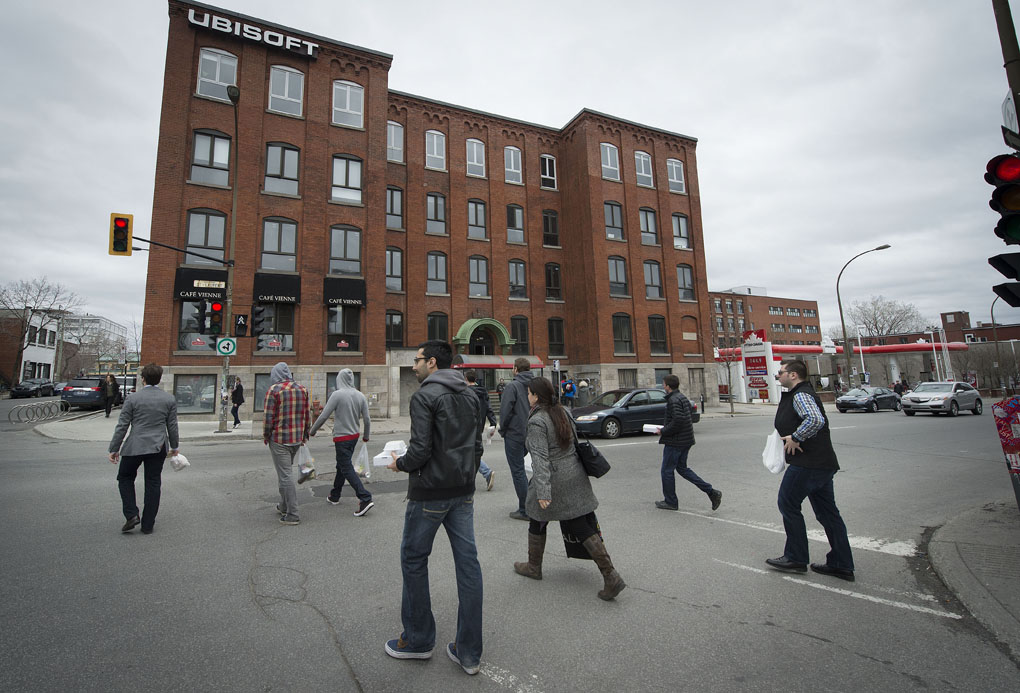 Ubisoft employees head back to work with their lunches around St-Laurent and St-Viateur Sts. Photo by Peter McCabe.
Ubisoft employees head back to work with their lunches around St-Laurent and St-Viateur Sts. Photo by Peter McCabe.
The new millennium also saw an influx of other types of businesses to the area, from quirky shops and innovative design firms to an initially-not-so-welcome chain tea shop.
François Hoang had moved his design studio, Aoiro, to St-Viateur St., last August. He was inspired by his surroundings, especially his most prominent neighbour.
“(Ubisoft) keeps me so motivated, they do something really really great,” he said. “They started so small, and now they have the whole freakin’ building.”
Ubisoft understands that it takes up a bit of space.
“We’re too big to pretend we don’t exist,” said Cédric Orvoine, the company’s vice-president of human resources and communications. “I believe it’s part of a company’s responsibility to be, at least, aware of its surroundings and environment.”
He said he believes Ubisoft’s impact to have been largely positive, but does concede that some people might not see it that way. “This type of big presence in a somewhat residential area can be a bit disruptive,” he said with a chuckle, mentioning the lunchtime crunch.
But the company has made a noted effort to gel with its surroundings. “I think we’ve proved that we took the time to understand the constraints, issues and needs of this community,” said Orvoine.
By the mid-2000s, Mile End had a solid reputation as one of Canada's pre-eminent artistic and cultural hubs — a demographic Ubisoft has a vested interest in preserving. Similar to the way Hoang found inspiration in the video-game giant, the company says it has much to gain much from the creative minds bustling around it.
“I am 100-per-cent convinced that we are a different company because we are here and we are not downtown in a big tower,” Orvoine said. “Nobody can make me change my mind on that.”
But as rents, taxes, foot traffic, flow of money, hype and newcomers increased, Mile End’s artistic community and residents have felt increasingly threatened. So, together, they mobilized.
“The reactions of the different stakeholders in this district has been very interesting ” said Simon of HEC Montréal. “We’ve seen a sort of counter-gentrification process.”
Through 2008 and 2009, the Mile End Citizen’s Committee organized a slew of “Café Citoyens,” open community brainstorms to discuss topics of concern to residents. At the table were artists, community members, politicians and representatives from local businesses including Ubisoft.
From these meetings came a comprehensive report and the birth of a variety of community-based organizations mandated to address different issues.
In 2008, Toronto-based Allied Properties Real Estate Investment Trust (REIT) acquired the Peck building. Then in 2011 and 2012, Allied purchased the two megastructures behind it, located at 5445 and 5455 de Gaspé.
- Cédric Orvoine, Ubisoft's vice-president of human resources and communications
The sale of 5455 confirmed any doubts that things were changing in Mile End — the building sold to Allied for nearly $30 million more than what it cost only four years earlier.
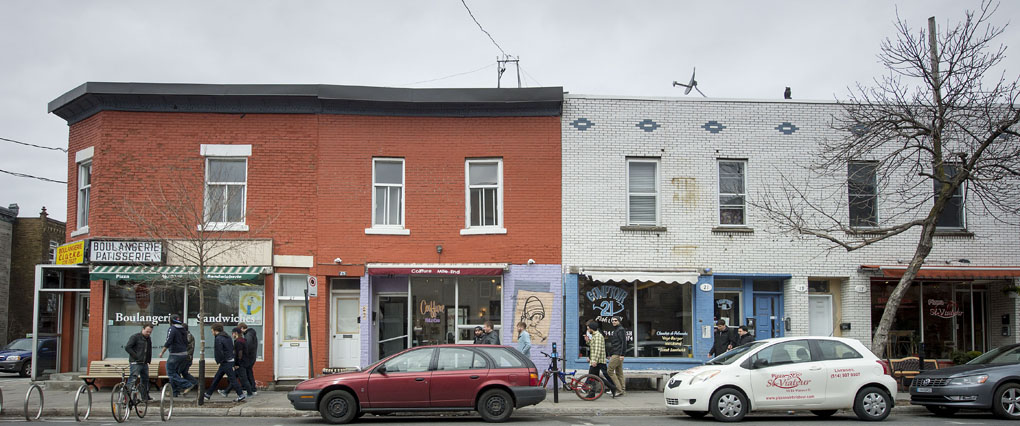 Local employees head for lunch on St-Viateur St. in Mile End. Photo by Peter McCabe.
Local employees head for lunch on St-Viateur St. in Mile End. Photo by Peter McCabe.Richard Ryan has lived in Mile End for more than 25 years; he calls it one of the most culturally dynamic neighbourhoods in the world. Ryan sat on the Mile End Citizen’s Committee before eventually running for office. He was elected as a Mile End district councillor in 2009 with Projet Montreal, and continues to hold the position today.
Ryan says the neighbourhood is becoming disturbingly financially inaccessible to many of its residents.“The speculation is making people leave,” he said. “The people who have less money, ordinary families, older families, families with multiple kids — we always say that the artists are threatened but we forget a lot of ordinary people who now can’t live here.”
In an attempt to help residents stay, Ryan and Plateau-Mont-Royal Mayor Luc Ferrandez have gotten creative.
In spring of 2012, they announced a zoning bylaw restricting the size and functionality of new businesses in the area. As a result, new property owner Allied was not permitted to fill the megastructures with another large-scale tenant, a-la-Ubisoft, and instead had to allow a patchwork of players into the space. This action was commended by local artists, and eventually, by Allied as well.
“It was a rather blunt form of planning, designed to limit the size of any given tenant in a building in an effort to protect the artistic community,” said Michael Emory, Allied’s CEO.
Allied learned quickly how engrained the artistic community was in Mile End and how adamant the neighbourhood’s politicians, residents and businesses owners were that things stay that way. So the company decided to embrace the situation.
“I think it is both a responsibility and a commercial necessity,” said Emory. “If we don’t understand the ecosystem we are becoming a part of, we won’t be successful economically or socially.”
The neighbourhood's artists saw another victory in April of 2013 when a groundbreaking deal was struck between Allied Properties and artist collective Pied Carré. The long-term lease agreement promised to protect 208,000 square feet of gallery and studio space in the de Gaspé megastructures from real estate speculation for a 30-year term.
That deal came courtesy of efforts from a variety of players from the government, the community and an endorsement from Ubisoft.
“There was this immense fear that we were going to come in and savagely displace the artists,” said Emory. “But, right out of the gate, Ubisoft said, ‘Look we like that building, we’re prepared to expand into the building — but you’ve got to be sensitive to the needs of the artistic community.”
And, as is evident by the deal, they were.
 Posters for indie rock concerts and cultural events seen everywhere in Mile End. Photo by Peter McCabe.
Posters for indie rock concerts and cultural events seen everywhere in Mile End. Photo by Peter McCabe.
Though it has certainly fizzled, the clothing manufacturing industry has not entirely disappeared from Mile End — what remains of it has, just like the artists, moved out of the Peck building and into the structures behind it.
Loukas Toliopoulos can be described as the changing face of the neighbourhood's clothing industry. He was born and raised in Mile End, just like his product Loukas Jeans — sewn on St-Viateur St., sold on Fairmont St.
Toliopoulos’s mother worked as a seamstress in the Peck building while she was pregnant, and his father later opened the family’s own factory business in 1995. The products they make and the customers they sell to has hugely changed since.
“We switched our focus to more higher-end products and products with a quick turnaround,” said Toliopoulos. He says his company’s new direction was simply a matter of evolution — “if you can’t adapt and adjust to times, then you’re just going to be wiped out completely.”
Times have definitely changed. Victoria Furfaro remembers when she used to buy $15 jeans just down the street from Olimpico. Now, that street features designer stores.
“Who would have thought,” she said. “Designer jeans on St-Viateur.”
High end or not, Toliopoulos still makes a point to advertise his jeans as a true Mile End product. With the area being a-la mode these days, he says using the neighbourhood's name as a branding coup has become somewhat a trend, even for newly-arriving businesses. “It’s the new hot thing, and everybody is going to capitalize on it.”
Ethan Song first heard of Mile End in 2007, when he was living in Vancouver. Last year, he moved his online menswear company Frank & Oak to 160 St-Viateur from Point St-Charles. Though still relatively new to the area, the company makes it explicitly clear that its products are “imagined in Mile End.”
“We associate ourselves with the values that we see the Mile End communicates,” Song said. “I think that it is both an attempt to make people aware of the neighbourhood and also for us to feel grounded in a specific space, values and design esthetic.”
Song said that in the last three or four years, he’s seen the neighbourhood develop to a point where people can work, shop, eat and live, and not really have to venture out.
“I think that if there is a time to move into Mile End, it's now,” he said. “We’re reaching a tipping point of enough traffic, enough coolness, enough stuff to do, and beyond that its going to get a bit more commercial.”
Roughly four decades ago, one of Mile End’s most celebrated artists was already sure his neighbourhood was on the verge of biting the dust.
Mordecai Richler grew up on St-Urbain in the '30s and '40s. In a CBC documentary filmed in 1975, he expressed concern for the future of his beloved childhood streets. “When all is said and done, I got this time and place right,” Richler said. “Because these alleys and these houses are doomed.”
He predicted that his childhood streets would one day be obscured by the shadows of high-rises. “Hopefully I will have been some kind of witness, and left a record of what was here at one time.” The neighbourhood as Richler knew it lives on in his works, including The Apprenticeship of Duddy Kravitz and St-Urbain’s Horseman.
Dan Seligman’s view of the neighbourhood's future is not as bleak. He’s the creative director and co-founder of international music and arts festival POP Montreal. Its offices used to be in the megastructures, but have relocated in recent years to a visible storefront on Park Ave.
“If it hasn’t happened already, it probably won’t,” Seligman said. “I think things will continue to change and develop, but just based on the demographics of the neighbourhood and the people who live here, I doubt there will ever be a Wal-Mart and a Starbucks side by side.”
He says there is a certain inevitability to the way Mile End is evolving — places will open and places will close — but that it will retain its artistic vibe.
“It’s an easy place to feel inspired, and see what’s happening,” said Seligman. “Even if its just through osmosis, to get a sense of creativity.”
Founded: 2010
Pied Carré is an artist collective that lobbies against rising rents. The organization works to keep gentrification from pushing out Mile End's artistic community. It struck a deal in 2013 with Allied Properties, owners of Mile End's megastructures on de Gaspé St., to protect all gallery and studio space for 30 years.
Founded: 1982
The Comité des Citoyens du Mile End is a 30-year-old community advocacy group that tackles everything from neighbourhood greening to trash collection. It organized community forums in 2008 and 2009, nicknamed the "cafés citoyens," to discuss the neighbourhood's future. The committee is now planning a series of similar meetings in 2014.
Founded: 1986
With branches throughout Quebec, CDEC (Corporation de développement économique communautaire) works to build and support local businesses and the social life flourishing around them.
Founded: 2004
Mile End/Montréal Pour Tous formed over concerns that rising rents would drive minority groups out of the neighbourhood. Initially Mile End-centric, this group has garnered much attention and support, which led to it expanding into a city-wide movement. The organization circulated a petition requesting a city-wide municipal tax freeze for 2014, 2015 and 2016 in light of corruption revealed at the Charbonneau Commission.Ateliers Créatifs
Founded: 2007
Alongside Pied Carré and CDEC, Ateliers Créatifs focuses on maintaining an affordable supply of artist spaces in Mile End.
Frank & Oak’s Ethan Song isn’t too worried about the future, either.
“I’m not a person to be afraid of gentrification — I’m all about progress,” he said. “I don’t think there is anything bad about the area. I think its great to create a movement.”
Song says people looking for a more niche space will move north. “You can’t stop it. But, I don’t think that’s a bad thing.”
But this migration is exactly what makes Richard Ryan shudder.
As the Projet Montréal councillor for Mile End sips a latte at Café Matina on Bernard St., he estimates that three-quarters of the clientele at this café and others nearby live north of here, in neighbourhoods such as Villeray or Rosemount.
“This is their community,” Ryan said. “They come here to be, and work — but people just don’t live here any more.” He says the change happened gradually in the '90s and 2000s, but that things have grown worse in last couple of years.
Ryan says Mile End faces “extreme” speculation, which poses a huge threat to the area’s social diversity — a long-standing source of pride.
Housing is a major concern. Ryan says the Plateau borough is going to have to get inventive.
During his mandate, Ryan hopes to obtain more power over housing from the city of Montreal.
At the end of the day, Ryan’s not sure he can win this fight. But, if he can’t keep Mile Enders here, he hopes he can at least keep them close.
He says that the neighbourhood was among the first to be audacious enough to fight the changes that threatened to drive out longtime residents and that, if nothing else, its actions can serve as an example for surrounding neighbourhoods to start implementing before it’s too late.
“Petite-Patrie, Hochelaga, Mile-Ex — if they can act now, we will achieve keeping people in this central area.”
Forde Cooper has been working at Café Olimpico on St-Viateur for 16 years.
“I'm living out in Villeray, because that's where I can afford to buy,” he said. “It’s not where I would have chosen to live — it’s great, I'm happy — but if I had the money I would have preferred to buy here (in Mile End).”
Cooper’s not surprised by the financially-dictated migration that’s happening out of Mile End. “It'll always happen, I think, anywhere that's kind of hot, and gets going — it happened to Brooklyn, happened to Williamsburg,” he said.
Once the people that make a place appealing move on, he added, they will take their appeal with them, and the cycle will continue elsewhere.
Cooper said his workplace is an integral part of the neighbourhood, and though things around them have changed dramatically, the the spirit of this place has not.
“We'll be keeping Olimpico nice and simple,” said Victoria Furfaro, Café Olimpico's co-owner. “My prices have been good for many years, we try to keep it old school.”
While some of the older small businesses have trouble weathering the changes, members of the community can at least take solace in the fact that its institutions are doing just fine. Everybody breathe, the bagels will still be here.
“The institutions will stay,” said Saul Restrepo, manager at the iconic St-Viateur Bagel bakery. ”That's why the others are coming, because we are here. This is good, it brings us new clients — but we're staying here, we're not going to move.”
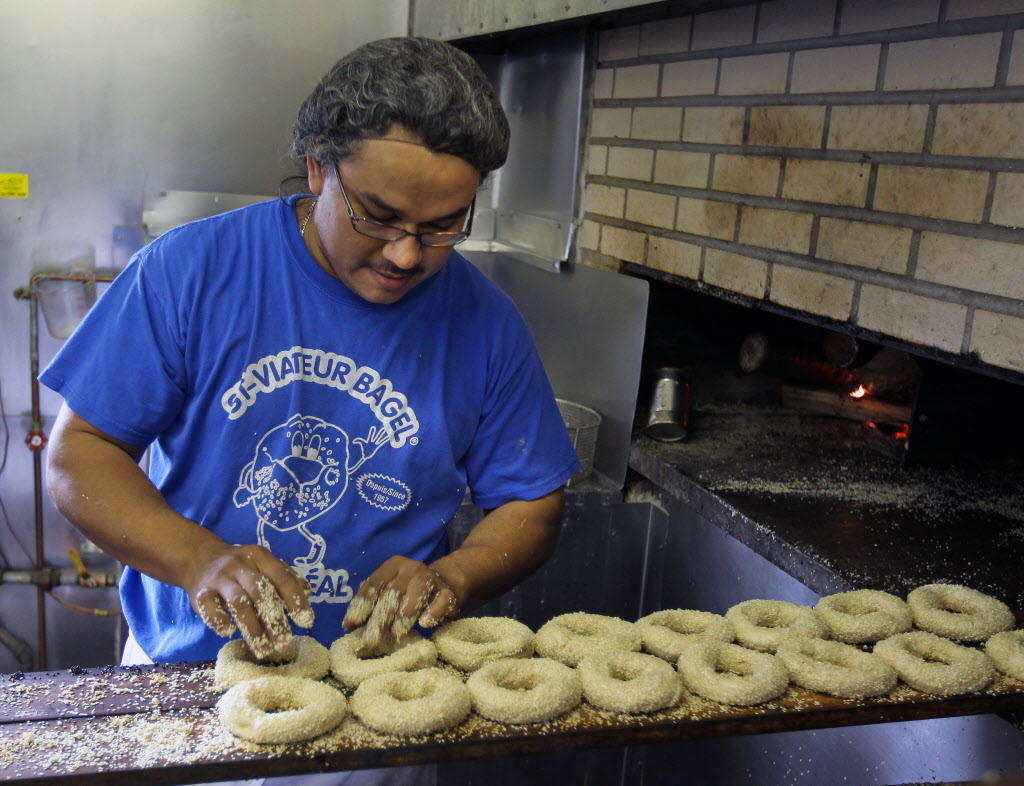 In this 2011 photo. Pedro Benitez prepares bagels for the wood-fired oven at St-Viateur Bagel bakery. Photo by John Mahoney.
In this 2011 photo. Pedro Benitez prepares bagels for the wood-fired oven at St-Viateur Bagel bakery. Photo by John Mahoney.
Meanwhile, the community will be renewing its efforts to keep people from leaving.
The Mile End Citizens’ Committee is gearing up for another round of “Café Citoyens” set to be held this spring. The committee is also planning a citizen’s forum in May.
“We feel like the population of Mile End is in the process of changing,” said Claudine Schiradin. “There are people here that might not even know who we are, so we have to reach out to them, and figure out how to do that.”
One of the neighbourhood’s most prominent property owners, Allied, plans on being here for awhile.
CEO Emory said the firm “loves the area” and is interested in continuing to invest in Mile End.
As far as keeping the artists in town, the real-estate company said it's not opposed. Emory said the renewal of Pied Carré’s 30-year lease is not only probable, but likely. But that’s still decades away.
Pied Carré co-ordinator Carine Valleau said one of the great community benefits to creativity is that it helps bring people together.
Valleau believes it is important for artists, and everyone else in the community, to be inclusive when looking ahead.
“What are the big privates going to do in this new Mile End? What should we do?” She said those players need to be invited into the community to work collaboratively on solutions in the next five years. So far, she says, “they’ve been willing to listen.”
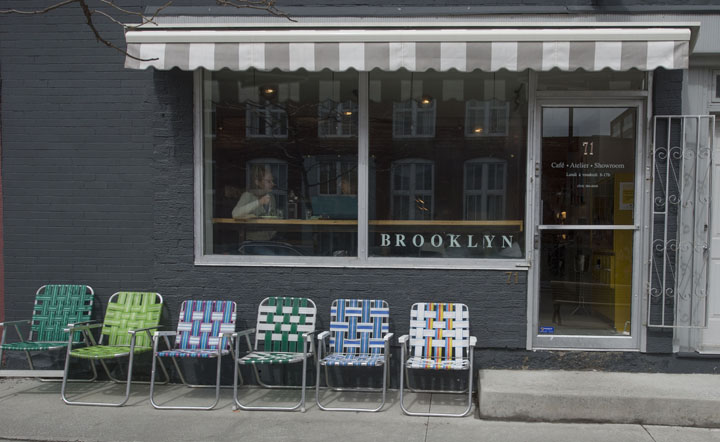 Lawn chairs sit outside café Brooklyn on St-Viateur St. Photo by Peter McCabe.
Lawn chairs sit outside café Brooklyn on St-Viateur St. Photo by Peter McCabe.
Ubisoft still feels it has a role to play, and just like Allied, the company plans to be here a long while.
“I hope what is pleasing us right now in the area is still going to be here in 2023,” Orvoine said, referring to the date when the company’s lease is set to expire.
In late September, Ubisoft announced the creation of 500 new jobs. Inevitably, these new jobs will invite even more change to the neighbourhood.
So the companies want to stay, the artists are fighting to stay, and the Mile End Citizen’s Committee is definitely staying.
And while some might say the neighbourhood isn’t what it used to be, the people who live and work here clearly see something worth fighting for.